How we create the proper learning environment
It all starts with getting to know and understand your dog.
The Maximum Canine Training Philosophy
The training philosophy at Maximum Canine is based around building a positive, cooperative relationship between dog and handler and creating a clear system of communication so that the dog understands what is appropriate and inappropriate behavior and consistently looks to make the correct choice. Because every dog is different, we take the time to evaluate what each dog finds valuable and use that to build a powerful bond that will show the dog why it wants to work with us.
Our trainers place tremendous importance on using release and play as a reward so that, once a behavior is completed, interaction with the handler is the value rather than a piece of food or a toy. Value for working is done by slipping expectations and commands into play sessions and then going back to play which creates a dog that wants to work with its owner and working together becomes the reward.
Our communication system is built upon clear markers and cues to prompt specific behaviors. We use forward classical conditioning where the command precedes an action so that the dog understands the verbal cue and not just the physical action associated with it. By putting a formula in place that the dog understands to teach and issue commands, it becomes significantly easier to introduce new behaviors by simply plugging them into the existing communication system that the dog already understands.
Looking at each dog as an individual allows us to find the most appropriate methods for teaching the dog what the correct answers are to each “question” they are asked. We slowly use progressively more difficult situations to help the dogs understand how they should respond to different distractions to prove the behaviors that we are looking for.
Creating the Proper Learning Environment
Motivation and Interest
We make sure that your dog wants to be in the learning environment. It starts by making sure the first impression counts! We accomplish this when we connect what the dog has a natural drive for and use the unconditioned drive to help the dog enjoy each session (hunt, prey, play, food).
Using Genetics
We figure out what your dog naturally wants to do and use that to build drive for the behaviors such as capture a sit from a Labrador and then let them go hunt in the woods for the ball or capture a sit from a Malinois and let them bite a tug as a reward.
Intelligence
Our trainers work hard to allow your dog to keep the excitement of the momentum of learning by not suppressing the dog's intelligence. Making predictions and seeing success is a rewarding process that will result in a dog that loves to work and learn.
We watch the dog's behavior as we train to make sure that we are allowing the dogs to problem solve and ending the session at the perfect moment where the dog has seen success and progress but before it gets burnt out. You may have heard of Chaser the Border Collie; he has learned the names of over 1,000 items and can find and retrieve items by name. He also has the incredible ability to recognize and find new items using the items he already knows by process of elimination.
Emotions in Learning
Dogs have emotions and feelings that will be conditioned to commands and environments. It’s important to create positive emotions for your dog when they’re learning new behaviors so that they can associate the commands with happiness and rewards.
If you give a “sit” command and the dog doesn’t sit and you hammer the dog, how will the dog feel the next time you ask for a sit? Anxiety, stress, etc. That is not something that you want in the learning environment.
Novelty in Learning
We also make sure to introduce any new treats, toys, or games to create immediate engagement, motivation, and interest.
Momentum of Learning
The process of keeping predictions moving increases the interest in learning so it’s important we don’t close the door and suppress the momentum when the dog is still being proactive and wants to keep learning.
Understanding Progression
Each behavior in the training process must get closer to the goal and our trainers study what your dog is seeing, doing, and completing to understand what will be the next step. We follow some of the following rules:
We redo the exercise if your dog fails and we teach you to mark the behavior as wrong and start from where your dog was last correct. We do this by immediately marking it as wrong and going back to the point just before the dog failed. We then do the entire exercise over so that the dog sees the picture of success
We do not allow your dog to self reward or be rewarded in the process. If your dog does not perform the correct behavior, your dog must understand it was wrong. An example of self rewarding is grabbing a treat off the floor, going to a position of value, etc.


